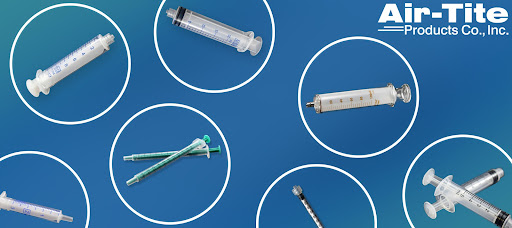
Pharmaceutical and laboratory syringes are used in various applications such as chromatography, compounding pharmaceuticals, and environmental sampling. There are many different types of syringes, each ideally suited to one or more applications.
At Air-Tite, many of our customers in the laboratory and pharmaceutical fields ask us the same questions about syringes. We decided to create this FAQ article to answer some of those more commonly asked questions so you can make a more informed buying decision.
NORM-JECT® and HENKE-JECT® syringes are more chemically resistant than many other options, but glass and metal syringes are the most resistant.
If you’d like to learn more, you can read this blog.
The answer to this question depends entirely on the experiment you’re performing. For example, if you’re seeking fine dosing of microliters, you should opt for a microliter syringe. Alternatively, if the substance you’re working with is sensitive to oil, silicone, or rubber, then a NORM-JECT® 2-part syringe will work best.
NORM-JECT® syringes are also ideal for chromatography applications, such as normal and reversed phase HPLC sample preparation procedures. They can work well in other chromatographic analysis techniques such as hydrophobic interaction, ion exchange, and size exclusion chromatography that use various aqueous buffer and salt solutions during the sample preparation protocols.
To read more about syringes for chromatography, you can read this blog.
Yes. They are REACH and RoHS compliant.
REACH (Registration, Evaluation, Authorisation and Restriction of Chemicals) compliance refers to a set of regulations that address potential environmental and human health hazards, specifically in regards to the potential use of certain materials in manufacturing, like lead, DMF, PAHs, Phthalates, AZO dyes, and PFOS.
RoHS (Restriction of the use of certain Hazardous Substances) compliance also addresses the use of hazardous materials in manufacturing, like lead, mercury, hexavalent chromium, polybrominated biphenyls (PBB), cadmium, and polybrominated diphenyl ethers (PBDE).
Luer lock syringes have threaded locking mechanisms at the tip to secure a needle hub. The hub of the needle is twisted onto these threads in a screw-like fashion to keep it “locked” in place. This is ideal for applications that produce a high amount of pressure, or just to provide an extra level of security for the user.
A luer slip syringe provides a quicker fit, where the needle hub is simply pushed (or “slipped”) onto the tip in a twisting motion. The friction from the standardized fit of the needle hub and the syringe tip keeps the needle attached.
Both luer lock and luer slip syringes accept standard hypodermic needles.
3-part syringes contain trace amounts of lubricating oil that help prevent the rubber plunger from sticking to the inside of the barrel. This oil can contaminate and skewer the results of certain laboratory and pharmaceutical applications.
2-part syringes, such as NORM-JECT® or HENKE-JECT®, do not utilize rubber or lubricating oil in their design. They instead use a slightly oversized and precisely engineered plastic plunger that expands the barrel and creates a vacuum on the downward pull.
Syringe manufacturers offer several customized solutions for higher volume applications, such as:
To read more about the differences between 2-part and 3-part syringes, click here.
Air-Tite brand 3-part syringes are ideal for many lab and pharmaceutical applications. They are not registered as medical devices for human use, so they are manufactured at a lower production cost—and a lower price for our customers—but to the same high ISO standards that govern general hypodermic syringes.
Read our comparison of Air-Tite and NORM-JECT® syringes here.
Many lab and pharmaceutical applications work with extremely expensive or rare products/substances. Dead space in a traditional needle can result in up to 99µl of wasted product, which can quickly add up over a short period.
A combination of Low Dead Space (LDS) needles and syringes for labs and pharmaceuticals reduce the amount of waste to almost zero. The patented design of the LDS needle hub results in a significant amount of potential product and cost savings.
Air-Tite carries several lab and pharmaceutical LDS syringe options, such as:
Amber syringes help to reflect certain UV light wavelengths, making them a more suitable option for light-sensitive applications. These syringes also help to disguise the coloring of medications inside, so they are often used in clinical trials as a control method. Air-Tite can special order large quantities of these syringes upon request.
There are four different types of medical infusion and laboratory pumps:
Each pump works best with several different types of syringes. Give us a call, and we’ll be able to make a recommendation based on your application and the type of syringe pump you’re using.
The polypropylene barrel of this LDS syringe contains a small amount of oleamide and acts as a slip additive. The lubricant facilitates easy gliding by migrating to the surface of the barrel when in use.
Any lubricant appearing on the barrel surface resides behind the piston in the non-fluid space. Due to the design of these syringes, repeated pumping of the syringe piston could potentially aggravate the embedded oleamide and cause it to rise to the surface and into the fluid path.
The manufacturers recommend these syringes be used with a single draw of the plunger to load the solution and then depress the plunger to expel. Due to the design of these syringes, repeated pumping of the syringe piston could potentially aggravate the embedded oleamide.
You can always contact us because we’re happy to suggest in-stock product alternatives.
At Air-Tite, we carry a wide range of syringes for lab and pharmaceutical applications. If you’re not sure which syringe will work best for you, give us a call, and one of our experts will help you select the right one. Click below to view our complete product line.
See Our Syringes